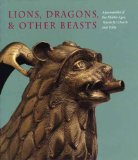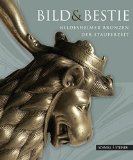|
Seen in a few illustrations of feasts and eating utensils are aquamaniles – a sort of pitcher used for hand-washing. Typical forms include animals, mounted knights or horsemen, and fantasical monsters; most of the surviving examples seem to be metal, but there are several ceramic examples too.
See also Aquamanilia.com for an interesting study of metal aquamaniles. Gothic and Renaissance Art in Nuremberg, 1300-1550 also has a section on aquamaniles (also available on Amazon).
(The medieval English word for an aquamanile seems to be laver.)
Following are examples of aquamaniles from museum collections and from medieval artwork. I am grouping them by form to provide better comparisons across different designs and styles. While lions appear with the greatest frequency among surviving examples, there are many other forms, including birds, centaurs, deer, dogs, dragons, gryphons, horses, humans (often on horseback), rams, and unicorns.
Last updated: Nov 8, 2021
- MFA 65.465, a male bust with raised hands, Magdeburg, late 12th-early 13th century
- GNM KG488, a kneeling man, Hildesheim, c. 1230
- Cluny Cl.990, the bust of a young man, bronze, Hildesheim, 1st quarter of the 14th century
- Hermitage Ф-3516, the head of a man, bronze, Hungary, second half of the 14th century
- Met 1975.1.1416, Aristotle and Phyllis, bronze, late 14th/early 15th century southern Netherlands
- Aristotle and Phyllis, bronze, late 14th/early 15th century northern Germany
- Hermitage Ф-92, Aristotle and Campaspa, bronze, late 14th/early 15th century Germany
- Musée Royal de Mariemont, bust of a young man, brass, 15th century
- Saint Martin of Tours dividing his cloak (Musée Royal de Mariemont), brass, 16th century
- Hermitage ИР-1567, an eagle, bronze with silver and copper, Iraq, 796-797
- Louvre MR 1569, a peacock, Spain, c. 972
- Musée Ducal 709, 12th century; painted in a Byzantine faience style, ornamented with green glaze, geometric motifs, and fish scales
- Met 1989.292, a rooster, copper alloy, Lower Saxony, 13th century
- GNM KG490, a rooster, Lower Saxony, 13th century
- Wolf (?) with a bird in its mouth and a smaller animal on its back, Germanic, 13th century
- Boijmans KB 54 (KN&V), brass, 1350-1400, Germany
- GNM KG583, Nuremburg, second quarter of the 15th century
- KHM Kunstkammer 83, gilded bronze with silver and niello, early 12th century Lower Saxony
- V&A 1471-1870, gilt bronze, Mosan or Germany, c. 1120
- Louvre OA 6924, copper, Lower Saxony, c. 1200
- Louvre OA 3049, Nuremberg, c. 1400
- Met 1975.1.1413, bronze, Nuremburg, c. 1425-1450
- Hermitage К3-5765, bronze, 6th-7th century Iran
- GNM KG582, Hungary, 12th century
- Rijksmuseum BK-NM-14111, bronze or brass, Maas, 13th century
- Met 10.13.4a, copper alloy, Nuremburg, c. 1400
- GNM KG262, Nuremburg, first half of the 15th century
- Met 47.101.53, copper alloy, Nuremburg, first half of the 15th century
- Met 52.24.2, copper alloy, Nuremburg, first half of the 15th century
- Musée Royal de Mariemont Mt123, brass, Germany, c. 1441-1460
- Hermitage Ф-1587, bronze, Germany, 15th century
- Horse-shaped aquamaniles at the Musée Royal de Mariemont , 15th century brass
- Hunt Museum CG 073
- National Museum of Denmark 2669 (possibly oriental/Islamic), c. 1200
- National Museum of Denmark D334/1970, c. 1200
- National Museum of Denmark 40, c. 1200
- Rijksmuseum BK-16911, bronze or brass, first half of the 13th century
- NGA 1942.9.280, bronze, 13th century England or Scandinavia
- British Museum 1853,0315.1, bronze, 13th century England
- Staatliche Museen zu Berlin F. 1479, 13th century Scandinavia
- Met 47.101.55, a falconer on horseback, Lower Saxony, 13th century
- Met 64.101.1492, copper alloy, Lower Saxony, c. 1250
- Stredoslovenské múzeum 5911, bronze, central Europe, c. 1250
- National Museum of Denmark 9094, c. 1250
- Knight on horseback, bronze, Hildesheim, second half of the 13th century
- National Museum of Denmark D333-D334/1974, bronze, found at Vigsø in Denmark, c. 1300-1350
- Met 1975.1.1409, bronze, Lower Saxony, c. 1350
- Met 47.101.54, coppr alloy, Nuremburg, early 15th century
- GNM KG712, Nuremburg, first half of the 15th century; may have also been a candleholder
- Museum der Stadt Regensburg K 1957/30, Regensburg, first half of the 15th century
- GNM KG584, Nuremburg, c. 1420-1430
- Walters 54.2434, a cheetah, Italy or Egypt, 11th-13th century
- Musée Royal de Mariemont D118, a man-eating lion, brass, 12th century
- Musée Royal de Mariemont 4567, brass, 12th century
- Sint-Servaaskerk, brass, 12th century
- Museum Vleeshuis 1887, brass, 12th century
- Christie’s Sale 2797, Lot 146, German, 12th century
- Met 64.101.1491, copper alloy with glass inlays, northern Germany, 12th century
- KHM 561, bronze with traces of gilding, 12th century
- Lion, bronze, late 12th century Magdeburg, Germany
- Lion, ceramic, 12th/13th century (possibly Islamic)
- Met 52.24.1, copper alloy, northern Germany, c. 1200
- Met 47.101.52, copper alloy with inlaid glass, northern Germany, c. 1200
- Hermitage A3-225, cow and calf attacked by a lion, bronze and silver, Iran, 1206
- National Museum of Denmark D795, a crowned lion, Hildesheim, c. 1200-1250
- Crowned lion, bronze, early 13th century Lower Saxony; similar to or same as crowned lion, Lower Saxony, c. 1220-1225
- Cleveland Museum of Art 1972.167, Hildesheim, early 13th century
- Met 1975.1.1410, copper alloy, Lubeck, c. 1230 (or early 19th century)
- V&A 560-1872, copper alloy, Lower Saxony, c. 1200-1250
- Boijmans KB 53 (KN&V), brass, Lower Saxony, c. 1200-1250
- Portland Art Museum 44.1, North German, c. 1200-1250
- Boijmans KB 61 ((KN&V), North German, 13th century
- V&A 246-1894, bronze, Hildesheim, c. 1215-1230
- Rijksmuseum BK-16910, a lion with a mounted female figure, bronze, c. 1230
- Louvre OA 9045, Lower Saxony, 1240-1260
- NGA 1942.9.281, gilded bronze, 13th century northern France
- Lion, bronze?, 13th century
- Boijmans KB 61 (KN&V), brass, northern Germany, 13th century
- British Museum 1851,0412.1, a man (Samson?) on the back of a lion, Germany, 13th century
- LACMA AC1992.152.100, copper alloy, Hildesheim, c. 1250
- Louvre OA 6938, Lower Saxony, mid-13th century
- Boijmans KB 60 (KN&V), brass, Hildesheim, c. 1250-1300
- Boijmans KB 59 (KN&V), brass, Hildesheim, c. 1250-1300
- Louvre OA 766, Lower Saxony, late 13th-early 14th century
- Met 64.101.1490, copper alloy, Lower Saxony, late 13th-early 14th century
- Met 32.100.198, copper alloy, Lower Saxony, late 13th-early 14th century
- Cluny Cl.2136, made in Hildesheim in the first quarter of the 14th century
- MFA 40.233, Samson fighting the lion, leaded latten, northern Germany, early 14th century
- Met 32.100.197, copper alloy, Lower Saxony, 14th century
- V&A 4054-1856, bronze, 14th century Germany
- Rijksmuseum BK-NM-77, bronze, Hans Apengeter, c. 1330-1335
- Hermitage Ф-1588, bronze, Thuringen, third quarter of the 14th century
- Rijksmuseum BK-16912, bronze, Meester Bernhuser, c. 1375-1400
- Met 1975.1.1412, Samson fighting the lion, bronze, possibly German, c. 1380-1400
- National Museum of Denmark D429/1972, found at the bottom of the sea near Hantsholm
- Rijksmuseum BK-16913, bronze, c. 1400
- Louvre OA 6939, Lower Saxony, c. 1400
- Walters 53.25, Germany or Netherlands, c. 1400
- Met 1994.244, copper alloy, Nuremberg, c. 1400
- Palais des Beaux-Arts Inv.A.286, Nuremberg, c. 1400
- Toledo Museum of Art 1953.74, copper alloy, Nuremberg, c. 1400
- Lion, Nuremburg, c. 1400
- Michael J. Whitman Antiques BA170, Germany, c. 1400
- GNM KG1340, Nuremburg, c. 1420
- Musée Royal de Mariemont 4568, brass, 15th century
- Musée Royal de Mariemont, brass, 15th century
- Musée Royal de Mariemont, brass, 15th century
- Christie’s Sale 7272, Lot 235, bronze, 15th century northern Europe
- V&A 561-1872, bronze, Germany, 15th-16th century
- Ram, ceramic, made in Scarborough between the late 12th and early 14th century
- Met 2007.142, Scarborough, c. 1250-1350
- Cluny Cl.2136, bronze, Lower Saxony, 4th quarter of the 13th century-1st quarter of the 14th century
- Met 64.101.1493, copper alloy, Nuremburg, c. 1425-1450
Other Ceramic Aquamaniles
These tend to be a bit blobby; the actual animal intended is sometimes quite vague.
- The Museum of London features fragments of ceramic aquamaniles made in England between the 11th and 14th centuries, including acc. nos. A16880, A22338, and A16796.
- Boijmans A 3280 (KN&V), Ulft, 13th century
- GNM Ke2564, 14th century Augsburg
- V&A C.343-1919, a stag, 14th century Rye
- Boijmans F 128 (KN&V), a salt-glazed stoneware quadruped, Siegeburg, 15th century
- Ceramic aquamanile (Musées Royaux d'Art et d'Histoire 1372) made in 16th century Raeren
- Louvre OA 6326, a sheep with polychromatic geometric decorations, Andalucia, 16th century
- Ceramic aquamanile (Töpfereimuseum) made in Raeren in the 1570s; has busts of Philip II of Spain and Anne of Austria
Other Aquamaniles
- Not really an aquamanile, but related: Met 47.101.56a, b, a turret laver, Germany, 15th century
- GNM KG489, a mermaid, mid-15th century Germany
- V&A 461-1873, a chimera, bronze, Italy, 16th century
- Some non-figural lavabos (hanging lavers), 15th-16th centuries, from churches and museums in Belgium: Kerk Sint-Paulus, Vollezele; Kerk Sint-Petrus en Urbanus, Huise; Kerk Sint-Marinus, Herk-de-Stad; Kerk Sint-Leonardus, Zoutleeuw; Kerk Sint-Eligius, Eine; Kerk O.L. Vrouw, Lichtaart; Kerk Sint-Niklaas, Dessel; Kerk Sint-Willibrordus, Kasterlee; Kerk Sint-Jan-Baptist, Weelde; Kerk Sint-Andries, Balen; Kerk Sint-Trudo, Eksel; another from Kerk Sint-Trudo, Eskel; Kerk O.L. Vrouw, Deinze; Kerk Sint-Martinus, Kerkom; Kerk Sint-Kwinten, Zonhoven; Kerk Sint-Laurentius, Bocholt; Kapel O.L. Vrouw der Bedruketn, Opitter; Kerk Sint-Odulphus, Borgloon; Kerk Maria Tenhemelopneming, Zutendaal; and this, this, this, this, and this at the Museum Vleeshuis in Antwerp; Eglise Saint-Pancrace, Focant; Eglise Saint-Lambert, Dinant; Musée Royal de Mariemont, Morlanwelz-Mariemont; and the collection of J. Frsart in Lige. A similar aquamanile appears in the center panel of the Mérode Altarpiece; I'm unsure whether this is meant only as a symbol of Mary's chastity & purity (as the ewer & basin in Campin's Werl Altarpiece and Madonna and Child or this detail of van der Weyden's Annunciation Triptych), or if it's meant to be seen as a typical element of 15th century Flemish domestic interior. Also V&A M.2669-1931, M.2676-1931, and M.2-1937, and Cleveland Museum of Art 1965.22.
Shop for reproduction aquamaniles: |


